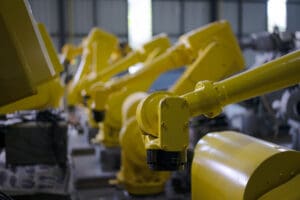Imagine a new model: a smaller number of American workers using labor-saving methods, who also get high wages out of a much bigger chunk of the corporate surplus, and whose resulting high spending then justifies continued investment in the same businesses.
By Ryan Cooper
For many years, rich oligarchs have posed as the engines of the economy — the entrepreneurs whose beneficence and wise decisions create economic prosperity. In a 2019 article for Fox News, Sally Pipes, president of the right-wing Pacific Research Institute, called for Americans to “celebrate America’s job creators” during Labor Day. “Let’s honor the people responsible for that grandeur — namely, the profit-seeking entrepreneurs and business people who make our economy hum,” she wrote.
This is bunk.
The real engine of the economy is the dollars in the pocket of the humble average citizen.
Since the Great Recession, numerous economists and writers (like myself) have argued over and over that fiscal stimulus — for instance, government spending on transfers or infrastructure — can create jobs and increase production for an economy mired in recession. This is undoubtedly true: as we have seen, the gigantic spending in the CARES Act last March did indeed save an economy in free-fall. The similar surge of spending in the American Rescue Package is already having a similar effect. More broadly, lack of sufficient stimulus is why we saw a solid decade of chronic high employment and weak economic growth.
But there is another side to the story. The above arguments tend to paint a picture of demand moving against an economic capacity that is fixed — with government priming the pump, we get the existing factories and whatnot going at full speed, and restore full employment.
In reality, as Skanda Amarnath and Alex Williams argue at Employ America, spending also affects overall capacity.
A factory, for instance, is not some immortal thing — at a minimum, it must be continually maintained because of entropy and ordinary wear and tear on equipment.
To remain competitive, it must be regularly upgraded with the latest production technologies. But businesses will logically invest in new capacity only if they see a market for the goods and services that capacity would produce. This is especially true with respect to high-tech manufacturing investment, which is very complex and expensive — taking over half a decade to pay off.
A key point that Amarnath and Williams make is that slack demand afflicted the U.S. economy long before the 2008 recession. We never actually recovered from the dot-com crash in 2001, particularly in high-tech manufacturing — the preceding ’90s tech boom saw a big surge in investment in semiconductor manufacturing and employment, which then stagnated for almost 20 years. It is only surging again now because of the huge boom in sales of computer products, as demand is for the first time far outrunning supply, and businesses are scrambling to take advantage. That’s thanks to newly remote workers needing to work from home, but also thanks to the huge government transfers to individuals in the various pandemic rescue packages.
Inequality also plays a big role in this story, because rich people disproportionately save their income rather than spending it. It follows that the more unequally income is distributed, the harder it will be to maintain the spending that would justify a healthy rate of investment.
Deregulation, union busting, and all the numerous Republican tax cuts for the rich funneled income to the top, and hence dragged down the economy relative to where it would have been otherwise.
Weak demand is also implicated in outsourcing. When businesses have chronically weak sales, they tend to pull in their horns and look to cut costs to preserve their profits, rather than reaching for new markets — often by moving production to lower-wage countries and cutting investment. “The 2000s and 2010s were marked by historically slack supply chains: weak aggregate demand, offshoring, and business model shifts acted in concert to shrink production relative to existing capacity,” Amarnath and Williams write. (Of course, slanted trade deals, financialization, and tax cuts for the rich are also major culprits here too.)
Finally, all this has knock-on effects on labor productivity. Chinese companies like Foxconn are based on a cheap labor business model — exploiting the low wages in China and other countries to make devices for Apple (and many other companies) using labor-intensive methods at a tiny profit margin, which are then sold to consumers at an eyewatering markup.
Imagine a different model: a smaller number of American workers building phones using labor-saving methods, who also get high wages out of a much bigger chunk of the corporate surplus, and whose resulting high spending then justifies continued investment in the same businesses.
Taken together, all this suggests that high incomes among the broad American population are even better than even many lefty commentators advertise. Cash in everyday Americans’ pockets is not only good in in the most basic sense (as people need money to live, of course) — their spending keeps businesses humming, investment high, and the overall economy healthy.
The latest surge in incomes is largely thanks to the transfers in the pandemic rescue packages. But new ongoing welfare programs — like Democrats making President Biden’s child allowance permanent — would have the same effect. So would reversing the last decades of deregulation and tax cuts for the rich, or sparking a new upsurge in labor organizing, or reforming the international trade system so that the world does not depend on chronic large American trade deficits. Let’s hope the pandemic stimulus binge was just the start of something bigger.
_____
To see original article please visit: https://theweek.com/articles/972951/american-consumers-are-real-job-creators




















